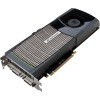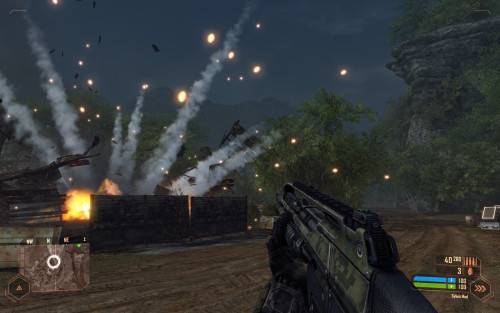- Qualcomm Launches Snapdragon 4 Gen 2 Mobile Platform
- AMD Launches Ryzen PRO 7000 Series Mobile & Desktop Platform
- Intel Launches Sleek Single-Slot Arc Pro A60 Workstation Graphics Card
- NVIDIA Announces Latest Ada Lovelace Additions: GeForce RTX 4060 Ti & RTX 4060
- Maxon Redshift With AMD Radeon GPU Rendering Support Now Available
NVIDIA GeForce GTX 480 – GF100 Has Landed

We’ve learned a lot about NVIDIA’s GF100 (Fermi) architecture over the past year, and after what seemed like an eternal wait, the company has officially announced the first two cards as part of the series; the GeForce GTX 470 and GTX 480. To start, we’re taking a look at the latter, so read on to see if it GF100 was worth the wait.
Page 7 – Crysis Warhead
Like Call of Duty, Crysis is another series that doesn’t need much of an introduction. Thanks to the fact that almost any comments section for a PC performance-related article asks, “Can it run Crysis?”, even those who don’t play computer games no doubt know what Crysis is. When Crytek first released Far Cry, it delivered an incredible game engine with huge capabilities, and Crysis simply took things to the next level.
Although the sequel, Warhead, has been available for just about a year, it still manages to push the highest-end systems to their breaking-point. It wasn’t until this past January that we finally found a graphics solution to handle the game at 2560×1600 at its Enthusiast level, but even that was without AA! Something tells me Crysis will be de facto for GPU benchmarking for the next while.
Manual Run-through: Whenever we have a new game in-hand for benchmarking, we make every attempt to explore each level of the game to find out which is the most brutal towards our hardware. Ironically, after spending hours exploring this game’s levels, we found the first level in the game, “Ambush”, to be the hardest on the GPU, so we stuck with it for our testing. Our run starts from the beginning of the level and stops shortly after we reach the first bridge.



The GTX 480 continues to taunt the HD 5870, beating it out at each one of our three resolutions. Surprisingly (or maybe not), the older dual-GPU GTX 295 outpaces the GTX 480 at 2560×1600.
|
Graphics Card
|
Best Playable
|
Min FPS
|
Avg. FPS
|
|
NVIDIA GTX 295 1792MB (Reference)
|
2560×1600 – Gamer, 0xAA
|
19
|
40.381
|
|
NVIDIA GTX 480 1.5GB (Reference)
|
2560×1600 – Gamer, 0xAA
|
23
|
37.135
|
|
ATI HD Radeon 5870 1GB (Reference)
|
2560×1600 – Gamer, 0xAA
|
15
|
34.41
|
|
ATI HD 5850 1GB (ASUS)
|
2560×1600 – Mainstream, 0xAA
|
28
|
52.105
|
|
NVIDIA GTX 285 1GB (EVGA)
|
2560×1600 – Mainstream, 0xAA
|
27
|
50.073
|
|
NVIDIA GTX 275 896MB (Reference)
|
2560×1600 – Mainstream, 0xAA
|
24
|
47.758
|
|
ATI HD 5830 1GB (Reference)
|
2560×1600 – Mainstream, 0xAA
|
23
|
41.621
|
|
NVIDIA GTX 260 896MB (XFX)
|
2560×1600 – Mainstream, 0xAA
|
21
|
40.501
|
|
ATI HD 5770 1GB (Reference)
|
2560×1600 – Mainstream, 0xAA
|
20
|
35.256
|
|
NVIDIA GTX 250 1GB (EVGA)
|
2560×1600 – Mainstream, 0xAA
|
18
|
34.475
|
|
ATI HD 5750 1GB (Sapphire)
|
1920×1080 – Mainstream, 0xAA
|
21
|
47.545
|
|
ATI HD 5670 512MB (Reference)
|
1920×1080 – Mainstream, 0xAA
|
20
|
35.103
|
|
NVIDIA GT 240 512MB (ASUS)
|
1920×1080 – Mainstream Detail, 0xAA
|
19
|
33.623
|
|
ATI HD 5570 1GB (Sapphire)
|
1920×1080 – Mainstream Detail, 0xAA
|
17
|
29.732
|
Given that Crysis Warhead is such a glutton when it comes to eating your PC’s hardware, I almost feel like there’s no such thing as a “best playable” when it comes to this title. Even if you have a top-of-the-line rig, you rarely can use settings that you’d imagine the PC could handle. So for this title, I’m a bit more lenient, and find that 30 FPS is very playable, which both cards manage to surpass. NVIDIA’s GTX 480 has a more desirable minimum FPS on average, though.
Support our efforts! With ad revenue at an all-time low for written websites, we're relying more than ever on reader support to help us continue putting so much effort into this type of content. You can support us by becoming a Patron, or by using our Amazon shopping affiliate links listed through our articles. Thanks for your support!






